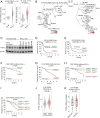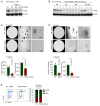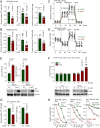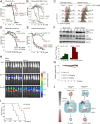PON2 subverts metabolic gatekeeper functions in B cells to promote leukemogenesis
- PMID: 33531346
- PMCID: PMC7896313
- DOI: 10.1073/pnas.2016553118
PON2 subverts metabolic gatekeeper functions in B cells to promote leukemogenesis
Abstract
Unlike other cell types, developing B cells undergo multiple rounds of somatic recombination and hypermutation to evolve high-affinity antibodies. Reflecting the high frequency of DNA double-strand breaks, adaptive immune protection by B cells comes with an increased risk of malignant transformation. B lymphoid transcription factors (e.g., IKZF1 and PAX5) serve as metabolic gatekeepers by limiting glucose to levels insufficient to fuel transformation. We here identified aberrant expression of the lactonase PON2 in B cell acute lymphoblastic leukemia (B-ALL) as a mechanism to bypass metabolic gatekeeper functions. Compared to normal pre-B cells, PON2 expression was elevated in patient-derived B-ALL samples and correlated with poor clinical outcomes in pediatric and adult cohorts. Genetic deletion of Pon2 had no measurable impact on normal B cell development. However, in mouse models for BCR-ABL1 and NRASG12D-driven B-ALL, deletion of Pon2 compromised proliferation, colony formation, and leukemia initiation in transplant recipient mice. Compromised leukemogenesis resulted from defective glucose uptake and adenosine triphosphate (ATP) production in PON2-deficient murine and human B-ALL cells. Mechanistically, PON2 enabled glucose uptake by releasing the glucose-transporter GLUT1 from its inhibitor stomatin (STOM) and genetic deletion of STOM largely rescued PON2 deficiency. While not required for glucose transport, the PON2 lactonase moiety hydrolyzes the lactone-prodrug 3OC12 to form a cytotoxic intermediate. Mirroring PON2 expression levels in B-ALL, 3OC12 selectively killed patient-derived B-ALL cells but was well tolerated in transplant recipient mice. Hence, while B-ALL cells critically depend on aberrant PON2 expression to evade metabolic gatekeeper functions, PON2 lactonase activity can be leveraged as synthetic lethality to overcome drug resistance in refractory B-ALL.
Keywords: B cell leukemia; glucose transport; lactonase; paraoxonase 2.
Conflict of interest statement
The authors declare no competing interest.
Figures






Similar articles
-
Metabolic gatekeeper function of B-lymphoid transcription factors.Nature. 2017 Feb 23;542(7642):479-483. doi: 10.1038/nature21076. Epub 2017 Feb 13. Nature. 2017. PMID: 28192788 Free PMC article.
-
Paraoxonase 2 Facilitates Pancreatic Cancer Growth and Metastasis by Stimulating GLUT1-Mediated Glucose Transport.Mol Cell. 2017 Aug 17;67(4):685-701.e6. doi: 10.1016/j.molcel.2017.07.014. Epub 2017 Aug 10. Mol Cell. 2017. PMID: 28803777 Free PMC article.
-
Paraoxonase 2 overexpression inhibits tumor development in a mouse model of ovarian cancer.Cell Death Dis. 2018 Mar 12;9(3):392. doi: 10.1038/s41419-018-0395-2. Cell Death Dis. 2018. PMID: 29531225 Free PMC article.
-
Insights into the role of paraoxonase 2 in human pathophysiology.J Biosci. 2021;46:4. J Biosci. 2021. PMID: 34987135 Review.
-
Paraoxonase-2 (PON2) in brain and its potential role in neuroprotection.Neurotoxicology. 2014 Jul;43:3-9. doi: 10.1016/j.neuro.2013.08.011. Epub 2013 Sep 4. Neurotoxicology. 2014. PMID: 24012887 Free PMC article. Review.
Cited by
-
Paraoxonase 2 (PON2) plays a limited role in murine lung tumorigenesis.Sci Rep. 2023 Jun 19;13(1):9929. doi: 10.1038/s41598-023-37146-5. Sci Rep. 2023. PMID: 37337025 Free PMC article.
-
Role of paraoxonase 2 (PON2) as a potential biomarker and therapeutic target in cancer treatment.J Cancer Res Clin Oncol. 2025 Aug 12;151(8):229. doi: 10.1007/s00432-025-06282-y. J Cancer Res Clin Oncol. 2025. PMID: 40794328 Free PMC article. Review.
-
Paraoxonase 2 is an ER chaperone that regulates the epithelial Na+ channel.Am J Physiol Cell Physiol. 2022 Jan 1;322(1):C111-C121. doi: 10.1152/ajpcell.00335.2021. Epub 2021 Dec 1. Am J Physiol Cell Physiol. 2022. PMID: 34852210 Free PMC article.
-
RHOA G17V induces T follicular helper cell specification and involves angioimmunoblastic T-cell lymphoma via upregulating the expression of PON2 through an NF-κB-dependent mechanism.Oncoimmunology. 2022 Oct 11;11(1):2134536. doi: 10.1080/2162402X.2022.2134536. eCollection 2022. Oncoimmunology. 2022. PMID: 36249275 Free PMC article.
-
Role of paraoxonase 3 in regulating ENaC-mediated Na+ transport in the distal nephron.J Physiol. 2024 Feb;602(4):737-757. doi: 10.1113/JP285034. Epub 2024 Feb 12. J Physiol. 2024. PMID: 38345534 Free PMC article.
References
-
- Buchner M., Swaminathan S., Chen Z., Müschen M., Mechanisms of pre-B-cell receptor checkpoint control and its oncogenic subversion in acute lymphoblastic leukemia. Immunol. Rev. 263, 192–209 (2015). - PubMed
Publication types
MeSH terms
Substances
Grants and funding
LinkOut - more resources
Full Text Sources
Other Literature Sources
Molecular Biology Databases
Miscellaneous

